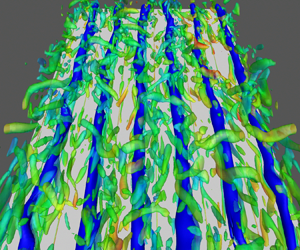Published online by Cambridge University Press: 10 May 2022

A turbulent drag-reduction method employing synthetic jet sheets in a turbulent channel flow is investigated by direct numerical simulations. The jet sheets are wall-parallel and produced by periodic blowing and suction from pairs of thin slots aligned with the main streamwise flow. By varying the slot height and the jet-sheet angle with respect to the spanwise direction, drag-reduction margins between  $10\,\%$ and
$10\,\%$ and  $30\,\%$ are obtained for jet-sheet angles between
$30\,\%$ are obtained for jet-sheet angles between  $45 ^{\circ }$ and
$45 ^{\circ }$ and  $75 ^{\circ }$, while a drag increase of almost 100 % is computed when the jet sheets are spanwise-oriented. When global skin-friction drag reduction occurs, the wall-shear stress near the jet-sheet exits increases during suction and decreases during blowing, while the velocity fluctuations weaken during suction and intensify during blowing. The global drag-reduction effect is produced by a finite counter flow induced by the nonlinear interaction between the jet-sheet flow and the main flow, although the turbulent intensity and Reynolds shear stresses increase. The power spent to generate the jet sheets is computed by modelling numerically the actuator underneath the channel flow as a piston oscillating sinusoidally along the spanwise direction in a round-shaped cavity from which the fluid is released into the channel through the cavity exits. A power balance leads to the computation of the efficiency of the actuator system, quantifying the portion of the piston power that is lost as internal power fluxes and heat transfer through the cavity walls. For the tested configurations, the power consumed by the piston to generate the jet sheets is larger than the power saved thanks to the drag reduction.
$75 ^{\circ }$, while a drag increase of almost 100 % is computed when the jet sheets are spanwise-oriented. When global skin-friction drag reduction occurs, the wall-shear stress near the jet-sheet exits increases during suction and decreases during blowing, while the velocity fluctuations weaken during suction and intensify during blowing. The global drag-reduction effect is produced by a finite counter flow induced by the nonlinear interaction between the jet-sheet flow and the main flow, although the turbulent intensity and Reynolds shear stresses increase. The power spent to generate the jet sheets is computed by modelling numerically the actuator underneath the channel flow as a piston oscillating sinusoidally along the spanwise direction in a round-shaped cavity from which the fluid is released into the channel through the cavity exits. A power balance leads to the computation of the efficiency of the actuator system, quantifying the portion of the piston power that is lost as internal power fluxes and heat transfer through the cavity walls. For the tested configurations, the power consumed by the piston to generate the jet sheets is larger than the power saved thanks to the drag reduction.